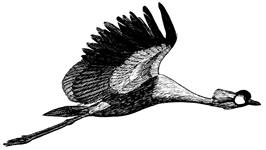Papers in the Biological Sciences
Date of this Version
January 1983
Abstract
The keeping of cranes in captivity, either as pets or as animals to be fattened for the pot, is evidently a very old practice. Captive cranes are depicted on the walls of the Temple of Deir-el-Barari of the Nile Valley, where cranes are shown walking in stately fashion between slaves. Each crane's bill is tied down close to its neck, which would upset its balance and thus prevent it from flying away (Whymper, 1909). Armstrong (1979) noted that cranes were apparently domesticated in ancient Greece, and that Plutarch (c. A.D. 46-c. A.D. 120) mentions the nesting of tame cranes, presumably Eurasian cranes. According to Rothchild (1930), a diary of the Moghul emperor Jenangir (1 605- 1627) mentions the breeding of sarus cranes in captivity. Additionally, crowned cranes were being maintained in Rome by at least as early as the fifteenth century, and a Eurasian crane was maintained for some 40 years by Leonicus Tomaecus, an Italian professor at Padua, at about the beginning of the sixteenth century. Live specimens of the Japanese crane also reached the Vatican by about the sixteenth century, as a gift from Japanese royalty (Topsell, 1972). Cheng (1981) stated that cranes were raised by Chinese royalty as early as the West Chou dynasty, some 2,200 years ago.


Comments
From Cranes of the World by Paul A. Johnsgard (Bloomington, IN: Indiana University Press, 1983; electronic edition: Lincoln, NE, 2008). Copyright © 1983 Paul A. Johnsgard.